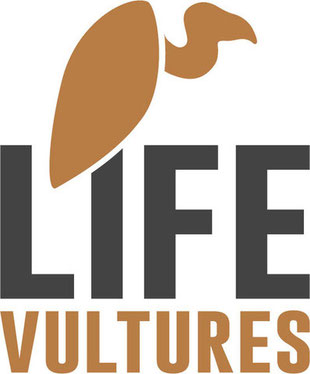
Vultures are a vital yet vulnerable part of European wild nature. A new memorandum of understanding between Rewilding Europe and the Vulture Conservation Foundation will enhance essential support for European vulture conservation and rewilding.
Towards more European vultures
Rewilding Europe and the Vulture Conservation Foundation (VCF) have signed a three-year memorandum of understanding (MoU), joining forces to strengthen vulture conservation and rewilding in Europe. The partners will work together to create, restore, enhance and maintain healthy vulture populations in Europe, with a significant proportion feeding on wild prey. They will also generate further support for vulture conservation by jointly communicating the importance of vultures in European ecosystems.
“Vultures, which play a vital role in nature as scavengers and keystone species, are also an essential part of European culture,” says Raquel Filgueiras, Rewilding Europe’s Head of Rewilding. “Through this agreement we will coordinate our efforts to make these magnificent birds a more common sight in European skies.”
“Throughout Africa, Asia and Europe, vultures faced and are still facing dramatic population declines over the years,” says Dr. José Tavares, Director at the Vulture Conservation Foundation. “In Europe, thanks to sustained and comprehensive pan-European conservation efforts, many led by the VCF, vultures are making a comeback and vulture populations are increasing. But there is still work to be done, and together with our partners, the VCF will continue to restore vulture populations to their former range across the continent.”
A mutually beneficial partnership
The two partners in the new MoU possess complementary strengths.
The Vulture Conservation Foundation, then known as the Foundation for the Conservation of Bearded Vultures (FCBV), was established in the 1970s to bring back the extinct Bearded Vulture to the Alps, by working alongside a network of vulture experts. Together, they established an international programme for breeding and reintroducing Bearded Vultures to the Alpine chain. After releasing hundreds of birds to the region, today the population is increasing with around 300 individuals and over 60 pairs. From that first Bearded Vulture reintroduction into the Alps, the VCF continued to reintroduce the species across France and Spain, connecting populations and has expanded its conservation efforts to cover all of Europe’s vulture species. Today, this international NGO uses its extensive experience in captive breeding, reintroduction, restocking, research, protection and conservation of vultures in their natural habitats, and is involved in many large-scale vulture conservation projects across Europe, from Portugal and Spain to the Alps, and throughout the Balkans to Greece and Cyprus.
In turn, Rewilding Europe has a practical, European-wide presence in the field, with three European vulture species (griffon, cinereous and Egyptian) found in five of the initiative’s rewilding areas. The griffon vulture breeds in the Greater Côa Valley (Portugal), Central Apennines (Italy) and Rhodope Mountains (Bulgaria), while it regularly visits the Velebit Mountains (Croatia) from a nearby colony. The cinereous vulture visits the Rhodope Mountains frequently from a breeding colony across the border in northern Greece, while it also visits the Greater Côa Valley, coming from nearby Spanish populations. The Egyptian vulture still breeds in good numbers in the Greater Côa Valley and in the Rhodope Mountains, although these populations are struggling to remain stable.
The bigger picture
Vultures require large areas of good quality natural habitat, which is increasingly difficult to find in Europe. In addition to their essential scavenging role as recyclers of natural carcasses, they are also of great value to local communities because they support nature-based tourism. Protecting vultures and ensuring they continue to benefit people, therefore means protecting entire European mountain ecosystems.
Linking vulture conservation and rewilding in Europe also has wider benefits. Improving the availability of natural carcasses for vultures means restoring wildlife populations, particularly herbivores (such as European bison and wild horses) and carnivores. An example of this is the reintroduction of fallow and red deer in the Rhodope Mountains rewilding area by the local rewilding team, which is boosting the availability of carrion for local vulture populations as a result of wolf kills.
Precarious position
Two centuries ago, the four European vulture species – Egyptian, Bearded, Cinereous and Griffon – were relatively common in southern Europe. Yet a decreasing availability of food, coupled with habitat loss, persecution and poisoning, saw them disappear from most of their range. At their lowest point, in the 1980s, there were only 2,000 pairs of Griffon Vultures and 250 pairs of cinereous vultures left in Spain.
Thanks to reintroductions and species protection, European vulture populations are now slowly but steadily recovering. Nevertheless, continued support is critical – the birds still face multiple threats, with the isolated nature of many breeding populations and low productivity rate of the species making the challenge of ensuring their long-term survival even greater. In the Rhodope Mountains rewilding area, where griffon vultures are making a gradual comeback, incidences of poisoning are still relatively common.
Next steps
Rewilding Europe and the VCF are already working together to support the comeback of griffon and cinereous vultures in the Rhodope Mountains rewilding area through the LIFE Vultures initiative.


As part of the new MoU, Rewilding Europe and the VCF have agreed a joint action plan through to the end of 2021. This includes specific actions to support vulture populations in the Rhodope Mountains, Central Apennines, Velebit Mountains and Greater Côa Valley rewilding areas, as well as collaborative efforts to advocate changes in EU vulture-related legislation.
Want to know more?





